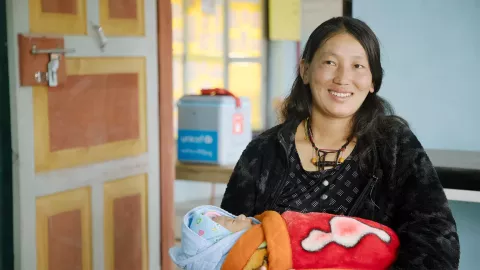In Kazakhstan, eating well can be a daily struggle
A boy and his mother explain why sticking to a healthy diet is hard when temptation is around every corner.

- Available in:
- English
- Español
ALMATY, Kazakhstan – Ten-year-old Yerzhan knows that his eating habits are far from perfect. “On a scale of 0 to 10, I’d give myself a 5,” he says.
And he knows what he needs to do better. “[I need] to cut down on milkshakes, burgers and soda,” Yerzhan says.
But as he prepares to tuck into dinner at his favourite food court in Almaty, Kazakhstan, it’s clear that for tonight, at least, that 5 isn’t turning into a 10. On the menu? Two double burgers, a milkshake and a cola.

Yerzhan’s mother, Shakhida, says it’s difficult to get children to eat healthily, especially when they are out.
“When you’re surrounded by people eating burgers or pizza at an event or in a shopping mall you can’t really resist the temptation or keep your child away from it,” Shakhida says. “You end up eating like everyone else.”
It’s a familiar story in Kazakhstan, which is seeing growing rates of obesity among young children. Around one in five children aged 5 to 19 is classified as overweight or obese.
The problem isn’t confined to Kazakhstan. Europe and Central Asia have been experiencing the sharpest rise in obesity among young children in the world, and the region now has the second highest prevalence of overweight children under the age of five.
Shakhida says that food manufacturers aren’t making it any easier for parents.
“Anywhere you look, there’s bright, colourful packaging,” she says. “The potato chips have flavours so strong it drives you crazy the moment you open the bag.”

Amirhossein Yarparvar, UNICEF specialist on nutrition for Europe and Central Asia, says that a better food environment for children isn’t just about the food itself, but improving overall health, education and social protection systems.
“We’re failing families like Yerzhan and Shakhida,” he said, ahead of the release of UNICEF’s State of the World’s Children report. “Governments, businesses, parents and caregivers all have to come together and make healthy options affordable, available and appealing.”
Slowly but surely
Despite the challenges, Shakhida and her family are doing better than before. She says that a couple of years ago she was suffering from what she thought was an allergic reaction. But after numerous tests and visits to the doctors, she was told that it came down to nutrition.
“I realized that I had to rethink my entire lifestyle,” Shakhida says. That has included breaking the connection between going out and eating fast food by cutting down on visits to the shopping malls or movie theatres that inevitably included buying sweet drinks and snacks.
Leading by example
But while Shakhida and Yerzhan both say that home cooked food is healthier than eating out, even that can be a problem in a country that has one of the highest consumption rates of salt in the world. A recent report by the World Health Organization found that popular homemade dishes like kebabs and kurt – a traditional Kazakh dish made of dried fermented milk rolled into balls – had at least half the recommended daily salt allowance in a single serving.
Shakhida says she is taking things one day at a time. But she knows that if she wants to make lifestyle changes stick with her son, she needs to lead by example.
“It’s not like I’ve been telling him not to eat or drink something while I keep eating it myself,” Shakhida says. “We do it together, and he can also see for himself that that I’m becoming more active.”

Achilles heel, in a cup
Yerzhan admits that he’s finding it difficult to give up drinking cola. “I’m trying to only drink soda once a month,” he says. “But at the moment I have some about once a week.”
Yerzhan isn’t alone in struggling to cut back on fizzy drinks. In Europe and Central Asia, more than 60 per cent of school-going adolescents don't consume vegetables on a daily basis, while almost one in three consume sweet soft drinks every day. Compounding the problem in Kazakhstan is the fact that children are exposed to a such a high volume of advertisements for foods that are high in saturated fat, trans-fatty acids, free sugars and salt, especially sweet carbonated drinks and confectionery.
Shakhida says that she tries to provide her son with alternatives, including encouraging him to drink water instead of cola. And when they are watching TV together and want to snack on something, she says she now cuts up some vegetables instead of just reaching for the potato chips.
Yerzhan says he is on board with the changes – up to a point.
“One day we brought carrots to the movie theatre. I think we made history,” he says, laughing. “There was a guy staring at us, I don’t think he could believe his eyes.”



